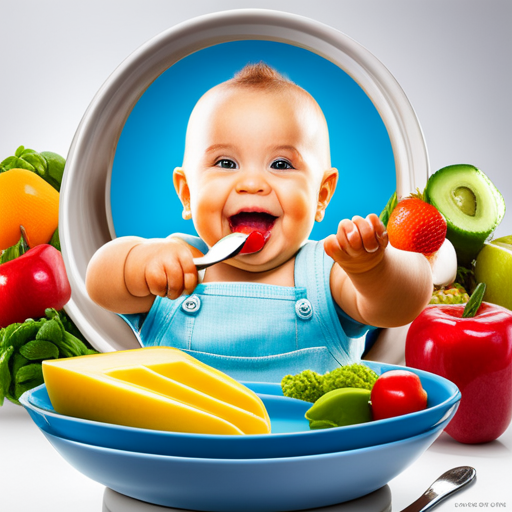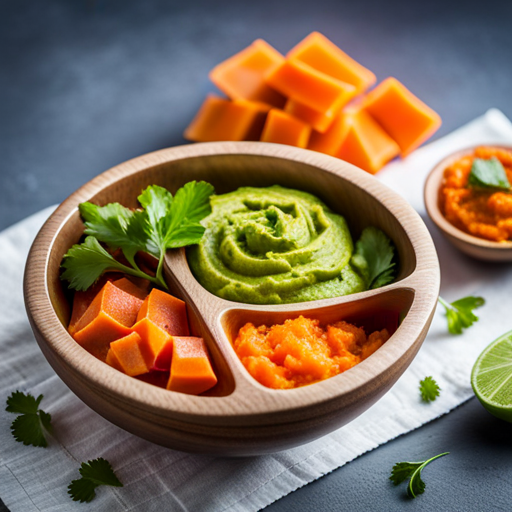"Cherishing Little Steps - A Haven for Baby and Family Journeys"
First Foods for Baby
Are you ready to embark on an exciting journey of introducing solid foods to your little one?
Look no further, because ‘First Foods for Baby’ has got you covered! As a parent, you understand the importance of providing your baby with the best nutrition for their growth and development. From the moment they take their first bite, you’ll witness their developmental milestones and taste preferences evolve.
But when is the right time to introduce solids? How do you go about it? Don’t worry, we’ll guide you through it all.
Get ready to discover the top recommended first foods for your baby and learn valuable tips for a smooth transition.
Let’s embark on this delicious adventure together!
Key Takeaways
- Offer a wide range of flavors and textures to encourage a varied and balanced diet.
- Start introducing solid foods when your baby shows signs of readiness.
- Choose between traditional purees or baby-led weaning methods.
- Homemade baby food allows control over ingredients and avoids additives or preservatives.
Nutritional Needs for Babies

To ensure proper growth and development, your baby’s nutritional needs are of utmost importance. When it comes to feeding techniques for picky eaters, it can be challenging to get your little one to try new foods. However, there are strategies you can employ to encourage a varied and balanced diet.
One approach is to offer a wide range of flavors and textures, gradually introducing new foods alongside familiar ones. You can also involve your baby in meal preparation or make mealtime a fun and social experience. It’s essential to be patient and persistent, as it may take several attempts before your baby accepts a new food.
Another aspect of your baby’s nutritional needs is identifying signs of food allergies. Common symptoms of food allergies in infants include rashes, hives, vomiting, diarrhea, or difficulty breathing. If you notice any of these signs after introducing a new food, it’s crucial to consult your pediatrician.
They can help determine if it’s an allergic reaction and guide you on how to proceed. In some cases, your doctor may recommend avoiding certain foods until your baby is older and their immune system is more developed. Remember to always introduce new foods one at a time, waiting a few days between each new food to monitor for any adverse reactions.
Developmental Milestones and First Foods

As your baby reaches important developmental milestones, you can begin introducing them to their first foods. These milestones, such as sitting up with support, starting to grasp objects, and showing an interest in what you’re eating, indicate that your baby is ready to explore new tastes and textures. It’s important to remember that every baby is different, and there’s no one-size-fits-all approach to introducing solids.
When it comes to their taste preferences, babies are born with a preference for sweet flavors. This is why many parents start with fruits or sweet vegetables like carrots or sweet potatoes. However, it’s important to offer a variety of flavors early on to help your baby develop a diverse palate. Introducing a wide range of tastes, such as bitter greens or savory foods, can help your baby become a more adventurous eater as they grow.
It’s also important to consider the texture of the foods you offer. Starting with smooth purees and gradually introducing more textured foods, like mashed or soft cooked pieces, can help your baby develop their chewing and swallowing skills. As your baby becomes more comfortable with different textures, you can start offering small, soft finger foods to encourage self-feeding.
Remember to always consult with your pediatrician before introducing solids and to watch for any signs of allergies or intolerances. By considering your baby’s developmental milestones and taste preferences, you can provide them with a positive and enjoyable introduction to the world of solid foods.
When to Introduce Solid Foods

Start introducing solid foods to your baby when they show signs of readiness. It’s an exciting milestone in your baby’s development and an opportunity for them to explore new tastes and textures.
But how do you know when your baby is ready? Look out for these signs: your baby can sit up with support, has good head control, shows interest in what you’re eating, and can move food from the front of their mouth to the back to swallow. These signs indicate that their digestive system is maturing and they’re ready for solid foods.
When introducing solid foods, it’s important to start with single-ingredient, pureed or mashed foods. This allows you to identify any potential food allergies or intolerances. Start with common allergenic foods such as wheat, eggs, peanuts, tree nuts, fish, and shellfish. Introduce one new food at a time and wait a few days before introducing another. This will help you identify any adverse reactions and determine if your baby has any food sensitivities.
Remember, every baby is different, and there’s no set timeline for introducing solid foods. Follow your baby’s cues and consult with your pediatrician if you have any concerns or questions.
Enjoy this journey of exploring new flavors together with your little one!
How to Introduce First Foods

You can begin introducing first foods to your baby by offering them a variety of pureed or mashed single-ingredient foods. This is an exciting milestone for both you and your little one. When it comes to introducing solids, you have two main options: traditional purees and baby-led weaning.
Traditional purees involve pureeing or mashing fruits, vegetables, and grains into a smooth consistency that your baby can easily swallow. This method allows you to control the texture and gradually introduce different flavors. Some popular puree options include mashed bananas, steamed carrots, and cooked sweet potatoes.
On the other hand, baby-led weaning encourages self-feeding from the start. Instead of purees, you can offer your baby soft and finger-sized pieces of food. This method promotes independence and helps develop fine motor skills. Suitable finger foods for baby-led weaning include cooked broccoli florets, avocado slices, and well-cooked pasta spirals.
Here is a table showcasing some puree options and finger foods for baby-led weaning:
| Puree Options | Finger Foods for Baby-Led Weaning |
|---|---|
| Mashed bananas | Cooked broccoli florets |
| Steamed carrots | Avocado slices |
| Cooked sweet potatoes | Well-cooked pasta spirals |
Remember to introduce new foods one at a time, and watch for any signs of allergies or choking hazards. Ultimately, the choice between purees and baby-led weaning is up to you and your baby’s preferences.
Top Recommended First Foods for Babies

Introduce nutrient-rich options to your baby’s diet with these top recommended first foods. When it comes to feeding your little one, there are several options that are both healthy and easy to prepare at home. One popular method is baby-led weaning, where babies are encouraged to self-feed with appropriately sized pieces of food. This approach allows them to explore different tastes, textures, and develop their motor skills.
Avocado is a great first food choice as it’s packed with healthy fats and essential nutrients like potassium and vitamin E. It can be mashed or sliced into small pieces for your baby to enjoy. Sweet potatoes are another excellent option, providing a good source of vitamins A and C, as well as fiber. Simply steam or bake them until soft and then mash them up.
Bananas are a popular fruit choice for babies as they’re easy to digest and are a good source of potassium. You can mash them up or cut them into small pieces for your baby to pick up. Additionally, homemade baby food is a fantastic option as it allows you to have control over the ingredients and avoid any additives or preservatives. Starting with simple, single-ingredient purees like cooked carrots, apples, or peas is a great way to introduce your baby to new flavors.
Tips for a Smooth Transition to Solid Foods

To ensure a smooth transition to solid foods, it’s essential to keep a few key considerations in mind. One approach that many parents find helpful is baby-led weaning. This method involves allowing your baby to self-feed from the very beginning, encouraging them to explore different textures and tastes at their own pace. It can promote independence and healthy eating habits. However, it’s important to note that not all babies may be ready for this approach, so consult with your pediatrician before starting.
Another crucial aspect to consider is the introduction of common food allergies. It’s recommended to introduce one new food at a time, waiting a few days in between each new food. This allows you to monitor any potential allergic reactions. Common allergenic foods include eggs, peanuts, tree nuts, soy, wheat, fish, and shellfish. By introducing these foods early on, you can help reduce the risk of allergies later in life. However, if you have a family history of food allergies, it’s best to consult with your pediatrician to determine the appropriate timing and approach for introducing allergenic foods.
Frequently Asked Questions
Can I Start Introducing Solid Foods to My Baby Earlier Than the Recommended Age?
You might be tempted to introduce solid foods earlier, but it’s best to stick to the recommended age. Starting too soon can lead to digestive issues and nutrient deficiencies. Let your baby’s development guide you.
What Are the Signs That My Baby Is Ready to Start Eating Solid Foods?
When your baby starts showing signs of readiness, like sitting up with support and showing interest in what you’re eating, it’s a good indication that they’re ready to begin transitioning to solids.
Are There Any Foods That I Should Avoid Introducing to My Baby as Their First Foods?
When introducing your baby to solid foods, it’s important to avoid certain foods that may be allergenic. These include nuts, shellfish, eggs, and honey. Consult with your pediatrician for a comprehensive list of foods to avoid.
How Can I Ensure My Baby Is Getting Enough Nutrients From Their First Foods?
To ensure your baby gets enough nutrients from their first foods, try these tips: introduce a variety of flavors to expand their palate, offer appropriate portion sizes for their meals. It’s like a mini culinary adventure for their tiny taste buds!
Are There Any Specific Feeding Techniques or Strategies I Should Follow When Introducing Solid Foods to My Baby?
When introducing solid foods to your baby, it’s important to consider feeding techniques that promote their development and cater to their food preferences. By following these strategies, you can ensure a positive and enjoyable feeding experience for both of you.
Conclusion
Congratulations on reaching the end of this informative guide! Introducing solid foods to your baby can be as exciting as a roller coaster ride. Remember to follow their developmental milestones and nutritional needs, and start with recommended first foods like mashed bananas or pureed sweet potatoes.
With patience and a smooth transition, you’ll be on your way to creating a healthy and enjoyable eating experience for your little one. So buckle up and enjoy the journey of nourishing your baby’s growth!


